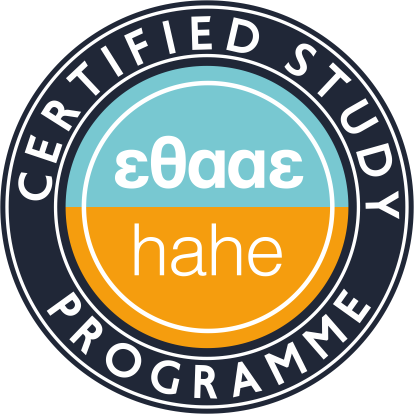General Description
-
Structure of undergraduate studies
- Duration of Undergraduate studies: five (5) academic years, each divided into two semesters.
- Duration of a semester: typically 13 weeks.
- Total number of semesters: ten (10).
- 'Winter' semesters: five (5) in total; 1st, 3rd, 5th, 7th and 9th.
- 'Spring' semesters: five (5) in total; 2nd, 4th, 6th, 8th and 10th.
A course is usually composed of a three-hour background theory and two-hour laboratory exercises or tutorials per week, usually not exceeding a total of 32h per week. The number of courses a student can attend each semester, may not exceed the number of courses defined by the curriculum plus three.
Eligibility to the 5-year degree requires the full participation of a student to the educational process structured by the sequence of curriculum courses. However, a student may extend the total period of study (or delay graduation) by selecting fewer courses than those recommended by curriculum each semester. Attendance of laboratory exercises and tutorials is compulsory; absences cannot exceed 1/5 of the total number of course –guided laboratory exercises or tutorials. Student enrollment in each semester, conducted either electronically or through the Secretariat of the Department, is obligatory. During enrolment, it is required from students to declare which of the ‘selectable’ courses wish to follow each semester. The registration period for the ‘winter’ semester is usually 1 September - 15 October, whereas that for the ‘spring’ semester is 10 - 25 January. Exact dates are promptly announced by the University. -
Educational trips
Educational trips, organized by the Department, are part of the training process and are, thus, obligatory. The trips are approved by the Senate, following the proposals of the Department, and take place typically after the end of ‘spring’ semester teaching classes and prior to the June examination period. In exceptional circumstances, educational trips can also be scheduled on particular dates to meet special educational purposes. The cost of the student trip is covered in part by the University.
-
Exams
Three examination periods: January - February, June and September. Exams are conducted after the end of each semester in all taught courses. To take the exams students should have previously filled-in an ‘exam entry form’ (either electronically or through the Secretariat office). Students must indicate the n + 3 exams they intend to participate (n is the number of current semester courses and 3 the courses from previous semesters).
In the September exam period, students may participate in all course exams (theory and laboratory classes) of the last two semesters and, furthermore, up to six theory course exams and six laboratory class exams, from previous semesters. According to the number of successfully concluded theory and laboratory exams, students can take exams for up to twelve theory courses and twelve laboratory classes from previous semesters.
Provisions only for 10th semester and ‘on degree’ students:
- ‘January - February’ examination period: students can participate in all theory course exams and lab class exams of the ‘winter’ semester and additionally in 12 courses (theory and lab class) of the ‘spring’ semester.
- ‘June’ examination period: students can participate in all theory course exams and lab class exams of the ‘spring’ semester and additionally in 12 classes (theory and lab class) of the ‘winter’ semesters.
‘September’ examination period: students can sit for exams of all courses (theory and lab class) of the ‘spring’ and the ‘winter’ semester. The theory course exams and the corresponding lab class exams and tutorials are independently treated and the student's performance is evaluated separately. The final grade indicates the average performance in theory and in laboratory or tutorial exams. The grade range falls within 0-10, with ‘five’ (5) as the passing mark.
